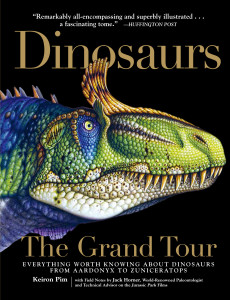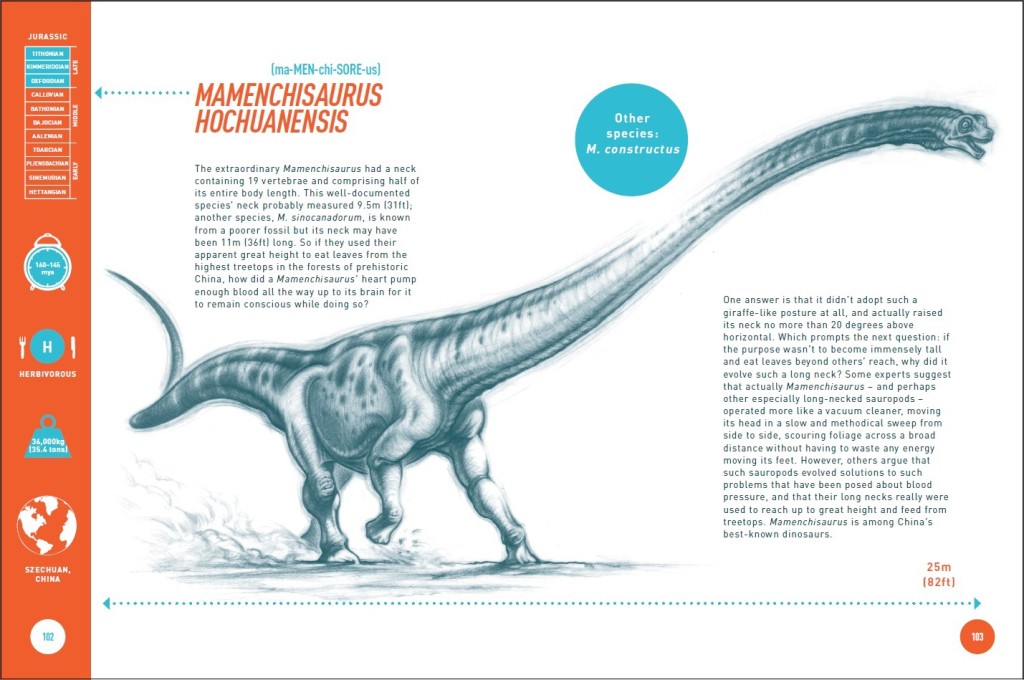Calling dinosaur enthusiasts and scholars of all ages! Keiron Pim’s Dinosaurs–The Grand Tour: Everything Worth Knowing About Dinosaurs from Aardonyx to Zuniceratops, with field notes by Jack Horner, is the indispensable guide to everything dino. The book is full of engrossing facts, important scientific findings, enlightening history, and of course, information on over 300 dinosaurs. Keiron sat down with us to reveal how he became so fascinated by dinosaurs and to answer all of our dinosaur and book-related questions!
Keiron Pim’s Dinosaurs–The Grand Tour: Everything Worth Knowing About Dinosaurs from Aardonyx to Zuniceratops, with field notes by Jack Horner, is the indispensable guide to everything dino. The book is full of engrossing facts, important scientific findings, enlightening history, and of course, information on over 300 dinosaurs. Keiron sat down with us to reveal how he became so fascinated by dinosaurs and to answer all of our dinosaur and book-related questions!
Q: Dinosaurs existed approximately 200 million years ago. Why do you think people remain so fascinated by dinosaurs after all this time?
Keiron: I think imagining the incredible size that some dinosaurs attained and the terrifying nature of predators such as Tyrannosaurus gives us a thrilling tingle–made all the more exciting by knowing that, while they might seem like monsters from the depths of our imaginations, dinosaurs were all too real and once pounded around the land that we walk upon today. There’s something mindboggling, too, about trying to conceive of such a great expanse of time, and it’s incredible to think that any fossilized relics of life back then should survive at all. Finally, and very importantly, it’s a subject that teaches you about many other fascinating subjects without your necessarily realizing it: read about dinosaurs and you’ll find yourself absorbing facts about geology, history, religion, astronomy, Native American mythology, and much more, all of which I’ve covered in my book.
Q: How did you get interested in the subject of dinosaurs, and what made you write this book?
Keiron: In London there is a wonderful Natural History Museum that houses a life-size model Diplodocus skeleton—in fact, you see it as soon as you come in, and it must make an overwhelming impact on every child who visits. It certainly did on me. I remember wanting to learn everything I possibly could about these amazing animals and poring over books that filled my mind with facts I could reel off later, as small children do. Thirty years later, I wrote this book because it seemed there was a gap in the market for an up-to-date, substantial yet engaging, and accessible account spanning the incredible diversity of dinosaurs, and it has been a thrill and a pleasure to immerse myself in their world.
Q: There are a lot of dinosaur books available—what is unique about yours?
Keiron: I hope that a few aspects set it apart: it is very stylishly designed (for which I take no credit at all; instead I refer you to Kristen Harrison at The Curved House art consultancy), it is beautifully illustrated by paleo-artist Fabio Pastori and, as far as my text goes, I’d like to think that it is, more than merely informative, also engagingly written. I am also delighted that Jack Horner has contributed field notes on fossil hunting and where to find American dinosaurs’ footprints—it’s a wonderful coup to have such an esteemed paleontologist contribute to the book, and I think that sets it apart, too.

Q: What are some of your favorite stories uncovered while researching this book?
Keiron: I loved learning about the Bone Wars, in which two 19th Century American paleontologists named Othniel Charles Marsh and Edward Drinker Cope waged an angry feud in which each sought to outdo and undermine the other: Marsh dynamiting his fossil excavation pits after his team had finished work so Cope wouldn’t be able to investigate them, Cope diverting a trainload of Marsh’s fossils to the wrong part of the country, Marsh publicly ridiculing Cope’s bad science, and more. It was an awful spectacle but out of their competition came many of the most famous dinosaur discoveries, among them Stegosaurus and Diplodocus.
Q: Do you have a favorite dinosaur?
Keiron: I think it depends on my mood! Some days it would be the speedy, bull-horned predator Carnotaurus, others it would be the fluffy tyrannosaur Yutyrannus, or perhaps good old Diplodocus, who always reminds me of childhood visits to the Natural History Museum. But more often than not I would have to say Spinosaurus, which stands apart for being so huge and so strange, so unlike most theropods with its crocodilian skull and its immense dorsal sail. Yes, I’ll go for Spinosaurus.
Q: The book contains tons of quick, interesting facts. For example, the name Maiasaura means “good mother lizard” because baby Maiasauras were cared for nearly twice as long as other baby dinosaurs. What facts did you find most surprising?
Keiron: I was amazed to learn about ‘island dwarf’ dinosaurs such as Europasaurus, a little sauropod (well, relatively little, it was still about 3m [10ft] tall). Because these dinosaurs lived on islands, they evolved into smaller versions of their mainland relatives in order to cope with the limited food resources. This phenomenon still occurs: For instance, skeletons of dwarf elephants have been found on islands such as Malta, Cyprus, and Sicily dating from relatively recent times, approximately 10,000 years ago. It also astonished me to learn how immense the mysterious Amphicoelias might have been, and I was intrigued by Jack Horner’s theory that some dinosaur genera are just other dinosaurs in a different growth stage: So the small herbivores known as Stygimoloch and Dracorex may just be young specimens of the larger Pachycephalosaurus.
Q: What is the question people most frequently ask you about dinosaurs?
Keiron: “What’s your favorite?,” closely followed by “Have you found any dinosaur fossils?,” to which I’m afraid the answer is “No,” though my fossil-hunting efforts have only consisted of wandering along the beach with my family while on holiday in Dorset, which forms part of southern England’s “Jurassic Coast.” I would love to attend a paleontological dig one day. By this you’ll gather that I’m not a paleontologist myself, but what I hope I am good at is researching this subject that I find so fascinating, and conveying what I find in an enjoyable and easily understood manner. I should give credit here to Dr. Darren Naish, a paleontologist at the University of Southampton, who most certainly is an expert and helped me ensure that my book is as accurate as possible.
Q: There seem to be all sorts of outlandish legends and theories about dinosaurs, their extinction, etc. What are some of the most interesting you’ve heard?
Keiron: Now and then some paleontologists pop up with ideas that others dismiss outright or politely suggest require more evidence before being taken seriously. Examples in the book include the suggestion that a little dromaeosaur called Sinornithosaurus was the only known venomous dinosaur—most experts are skeptical about this—and a couple by Phil Currie, the well-known Canadian palaeontologist. He suggests that Tyrannosaurus hunted in packs, a theory that many other experts feel needs more evidence, and that Diplodocus could swing the tip of its tail faster than the speed of sound, creating a cracking noise like a bullwhip that would scare away predators.
Q: The study of dinosaurs isn’t a new field, but your book is more than just a catalog of existing data. What types of new research or recent finds do you discuss in the book? Is there still more for scientists to learn about dinosaurs?
Keiron: I was really keen that the book should be up-to-date not only in featuring recently discovered creatures—e.g. Yutyrannus and the terrifying Jurassic marine reptile Pliosaurus—but also in describing the modern research techniques that paleontologists employ. So I mention the computer-modeling techniques that have suggested the huge pterosaur Quetzalcoatlus could indeed fly, contrary to suggestions that it was too heavy to get off the ground, and I describe how researchers have used scanning electron microscopes to examine fossilized pigment cells from Sinosauropteryx, Anchiornis, and Archaeopteryx to reveal these feathered dinosaurs’ likely colors. Similarly I explore the groundbreaking research into dinosaurs’ connections with birds and take in the work of paleontologists Mary Higby Schweitzer and John Asara, who claim to have extracted soft tissues and protein sequences from a Tyrannosaurus bone. They note that of all creatures alive today, the one whose amino acid sequences most resemble those of Tyrannosaurus Rex is: the chicken!
Of course, there is always more to learn. One of the exciting things about paleontology is the pace of change, and if I were to revise my book in a decade’s time I’m sure it would feature a host of incredible animals that we haven’t yet unearthed, and a more detailed understanding of many of those we already think we know.
Q: Paleontology seems to be changing daily—is there new information out even since you wrote the book?
Keiron: Given the pace of progress, with new dinosaurs discovered every month, it seemed inevitable that as soon as my book went off to the printers an important new find would be revealed. Sure enough, in September 2014, paleontologists unveiled Dreadnoughtus, one of the biggest known sauropods and the heaviest one whose weight can be calculated with any great certainty. It left a relatively complete fossil skeleton, whereas most sauropod remains are so partial that estimating their weight involves a fair amount of speculation. It’s thought that Dreadnoughtus weighed about 59,000 kg, equivalent to a dozen elephants.
All I can say is that my book was as up-to-date as I could make it at the time of going to press. It just goes to show what an exciting field paleontology is—it’s very hard to keep up.
Q: Jack Horner, world-renowned paleontologist and technical advisor on the Jurassic Park films, did the field notes for your book. What do you think about the upcoming movie, Jurassic World?
Keiron: When the first Jurassic Park movie came out in 1993 I was 15, and I remember well the buzz of excitement at the prospect of seeing dinosaurs depicted more realistically than ever before. Sure, what we saw didn’t turn out to be totally realistic—Velociraptor was small and feathered rather than large and scaly—but it was still great entertainment. I’m sure Jurassic World will be very entertaining too, and I look forward to watching it, though I think the filmmakers’ decision to depict all the dinosaurs as scaly even though we now know many to have been feathered is a disappointing missed opportunity. They could have shown the general public just how far paleontologists’ understanding of dinosaurs has progressed, and just how bizarre many dinos appeared compared with our old picture of them, but instead they’ve gone for what’s tried and tested. I guess that’s Hollywood for you!
This interview can be reprinted in part or in its entirety with the following credit line:
Interview with Keiron Pim, author of DINOSAURS—THE GRAND TOUR: Everything Worth Knowing About Dinosaurs from Aardonyx to Zuniceratops (The Experiment, Fall 2014). www.theexperimentpublishing.com




